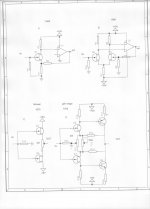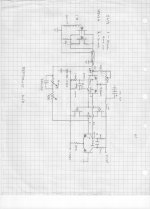Why? We don't really need preamps anymore. Source signal levels are generally in the 2-4V range, enough to clip most power amps.
So what ..? very few source systems won't benefit from a pre, Scott should give us his version of a ranking Pre ....
Just saying ...

I spoke this morning, at length with Mitch Cotter about how he used the AD797 for the preamp that he and Dick Sequerra made. It was an 'eye opener, and THEN he proceeded in telling me HOW he made the Sequerra phono stage. He and I are on the SAME track and have been for the last 30 years. The use of the AD797 was only a convenience to save designing a discrete circuit, and it was NOT used as normally specified.
So what ..? very few source systems won't benefit from a pre, Scott should give us his version of a ranking Pre ....
Just saying ...

Walt Jung published his AD823/AD815 composite line stage just after his super-regulator. That's what I used for years (the two together). Can't see much need to improve on that for medium levels and interconnect driving.
Myself, for phono use the now unobtainable high-hat Toshibas in a Zen like open-loop two stage RIAA ala Walt's article.
Stacked AD745's would do for the Grado, if I ever get to the Denon I plan on an all out Zen (one FET and optical biasing so no coupling cap) with the exotic Interfet devices (~.28nV fingers crossed) that Pass Labs was kind enough to send me.
Last edited:
very few source systems won't benefit from a pre
Why? There's a benefit to adding an unneeded box (other than to people selling those boxes)?
In a world without vinyl this works. I live in a world with vinyl.Why? We don't really need preamps anymore. Source signal levels are generally in the 2-4V range, enough to clip most power amps.
What the heck, Scott. Just put a couple of IC's together! '-)
Walt too, I get positive inputs from a bunch of guys in your posse and it's not good enough? Jim Bongiorno loved the 823 and even insisted on meeting the designer.
The pre-amp shoot out can't happen anyway unless the cartridge noise dominates. Simply ID'ing the noise floor unblinds the test.
Just put the jfet in front of the IC.
Mine are built in.
Walt Jung published his AD823/AD815 composite line stage just after his super-regulator. That's what I used for years (the two together). Can't see much need to improve on that for medium levels and interconnect driving.
Myself, for phono use the now unobtainable high-hat Toshibas in a Zen like open-loop two stage RIAA ala Walt's article.This definately needs a rebuild since it got stepped on in my recent reclaim of my mancave. I sure hope the leads don't break off at the package when straightened.
Stacked AD745's would do for the Grado, if I ever get to the Denon I plan on an all out Zen (one FET and optical biasing so no coupling cap) with the exotic Interfet devices (~.28nV fingers crossed) that Pass Labs was kind enough to send me.
Grado! Jfet's.! whoooaa buddy , you're killing the vibes ..
Why? There's a benefit to adding an unneeded box (other than to people selling those boxes)?
could be worst, they could be using em to sell tooobs......
In a world without vinyl this works. I live in a world with vinyl.
Yep ...

Mine are built in.Got my 40 year service award yesterday now I can say it, "40 years ago....".
Congrats ...... Dog
Paul join the fray, must have heard about JC's wilson step up ........ 
Building a new Music Room Part 7 - YouTube
I wonder if Paul's using any AD745's...?

Building a new Music Room Part 7 - YouTube
I wonder if Paul's using any AD745's...?

Last edited:
I am thinking of a way to test jn ideas without doing impedance sweeps and I would like your opinion.
Time-domain reflectometry - Wikipedia, the free encyclopedia
TDR on the cheap something like this: Cheap and simple TDR using an oscilloscope and 74AC14 Schmitt Trigger Inverter - YouTube
The inverter based pulse oscillator will be set to a few different frequencies-minimum three- say 100Hz, 1kHz, 10kHz.
Each set of Zline/Zload combination will be tested with a pulse at these three repetition frequencies.
The idea is for each case, the end of line reflection delay to be measured on the screen, written down and then compared with the delay from the tests with the other frequencies and line/load sets.
What I have doubts of is: What will be the actual frequency that will test the line/load set?
Is it the pulse repetition frequency or is it the frequencies that will be generated by the fast rising edge of the pulse?
If it is the latter, does the pulse have to be LP filtered at the selected frequencies?
George
Time-domain reflectometry - Wikipedia, the free encyclopedia
TDR on the cheap something like this: Cheap and simple TDR using an oscilloscope and 74AC14 Schmitt Trigger Inverter - YouTube
The inverter based pulse oscillator will be set to a few different frequencies-minimum three- say 100Hz, 1kHz, 10kHz.
Each set of Zline/Zload combination will be tested with a pulse at these three repetition frequencies.
The idea is for each case, the end of line reflection delay to be measured on the screen, written down and then compared with the delay from the tests with the other frequencies and line/load sets.
What I have doubts of is: What will be the actual frequency that will test the line/load set?
Is it the pulse repetition frequency or is it the frequencies that will be generated by the fast rising edge of the pulse?
If it is the latter, does the pulse have to be LP filtered at the selected frequencies?
George
Too much Irony,I'm still waiting for an answer on how you tell when the wire is neutral ...

You can't measure a simple wire? What hope is there for you then? How's that for irony?
Flat frequency response would seem to be a great way to know huh?
No obscure phase changes.
Can you not tell when the bass or midrange or treble is depressed or elevated in a speaker? Same rules apply.
Now go out and find me a cable that doesn't sound neutral and measure it.
Come back and talk about irony when you can make your point objectively.
If you use a lot of this........
 .......then everything will sound different after a while.
.......then everything will sound different after a while.- Status
- Not open for further replies.
- Home
- Member Areas
- The Lounge
- John Curl's Blowtorch preamplifier part II

